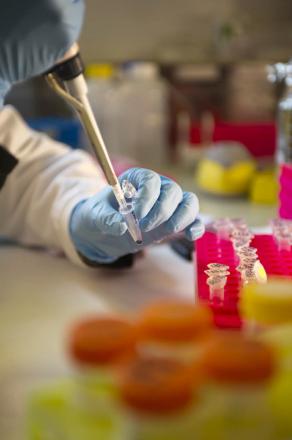The mission of the Department of Prion Disorders and Related Infectious Agents (SEPIA) is to develop and evaluate research strategies in response to public health issues raised by prions and prion-like or atypical pathogens. Current research suggests that these protein-based infectious mechanisms may underlie the main neurodegenerative diseases and particularly Alzheimer's disease.
Developing a prion test
 Following a request from the French Ministry of Agriculture formulated during the first "mad cow disease" (bovine spongiform encephalopathy; BSE) outbreak in 1996, SEPIA developed a rapid prion purification method and a number of diagnostic approaches. Those efforts resulted in several patents and a rapid diagnostic test, which was evaluated in Europe (Moynagh et al, Nature 1999) and thereafter licensed to an industrial partner (Bio-Rad). That test proved to be as sensitive as animal inoculation for the detection of the abnormal prion protein (Deslys et al, Nature 2001) and went on to contribute to food safety via its implementation in Europe's systematic screening for BSE in slaughterhouses. Following a request from the French Ministry of Agriculture formulated during the first "mad cow disease" (bovine spongiform encephalopathy; BSE) outbreak in 1996, SEPIA developed a rapid prion purification method and a number of diagnostic approaches. Those efforts resulted in several patents and a rapid diagnostic test, which was evaluated in Europe (Moynagh et al, Nature 1999) and thereafter licensed to an industrial partner (Bio-Rad). That test proved to be as sensitive as animal inoculation for the detection of the abnormal prion protein (Deslys et al, Nature 2001) and went on to contribute to food safety via its implementation in Europe's systematic screening for BSE in slaughterhouses.
|  Emmanuel COMOY Director
Secretary Dolorès JOUY Tel: + 33 (0)1 46 54 81 05
|
Industrial partnerships
SEPIA provides expertise and welcomes collaborative research teams to enable the evaluation of decontamination methods for numerous industrial partners. In its own initiatives, the department develops new methods to reduce proteinaceous infectious threats, not only in medical and surgical fields (
Fichet et al, Lancet 2004), but also in food & agriculture, with an eye on sustainable development. For example, SEPIA participates in the ANR's Project Desirable evaluating how insects may contribute to protein production and the valorization of organic materials currently considered as waste. That pathway, upon which insects recycle organic waste and thereafter become food for other animals (fish and poultry), must be laid with a total control of infectious risks, notably those involving prions.
A springboard for tech startups
For its prion research needs, SEPIA has developed numerous innovative methodologies, particularly within its close partnership with the learning institute Sup'Biotech for the development of novel biotechnological approaches and its hosting of a research team (2013). Two startups have been launched thanks to valorization work done at SEPIA: Weconext in 2011 and Theranexus in 2013. To best valorize the technological expertise developed in its laboratories, SEPIA is testing a platform dedicated to the rapid and effective emergence of innovative biotech projects in collaboration with engineering students from Sup'Biotech.
Expertise covering basic to applied research
More fundamentally, SEPIA has acquired unique expertise through its development of original primate models that imitate human disease with unmatched accuracy. One of these models provided the first experimental demonstration of BSE transmission (
Lasmézas et al., Nature 1996), thus furnishing tangible elements for the evaluation of primary and secondary public health risks as concerns animal-borne prion diseases. This has enabled the demonstration of previously undiscovered blood-communicable forms of disease that had remained hidden from classical methods. These models also enable the study of human healthy carriers, in whom disease may remain undetectable, probably for decades. The potential impact of healthy carriers on public health is an important issue, particularly for the safety of blood transfusions at the national and international level. A British study (
Gill et al, BMJ 2013) reported a healthy carrier prevalence of 1/2000, i.e., close to 200 times the total number of diagnosed or expected cases of variant Creutzfeldt–Jakob disease (vCJD) in the United Kingdom, according to models. SEPIA is associated with the
French national reference center for prions and unconventional transmittable agents. It also provides coordination for the
NeuroPrion Network of Excellence (FP6, sustained by the NeuroPrion Association, which organizes a yearly international conference on prions).
New innovative processes to understand the complexity of life
Understanding the modifications incurred by the brain in the course of
prion and prion-like neurodegenerative diseases is an arduous task. Adding to
that complexity is the interplay of novel molecules used as pharmacological
tools for the development of therapies against these diseases. To obtain a
better grasp of these dynamics in different pathophysiological settings, SEPIA
has developed a number of specific tools. The department has access to a
library of 800 pEBV-siRNA vectors targeting 160 human genes in a range of
metabolic pathways. This patented cell line technology is marketed under the
name "SilenciX". It offers a wide range of applications, from basic
research to the development of new drug screening technologies. SEPIA employs
iPSC technologies (pluripotent stem cells induced from adult skin or blood
cells) that have enabled the development of 3D cellular models mimicking human
brain organization (Lancaster et al., Nature 2013). These "minibrain"
3D culturing models offer great potential. They reside intermediately between
classic 2D cellular models and in vivo
models (notably transgenic mice) and participate in a logic of increasing high
throughput screening capacities and reducing animal experimentation needs. A
project called 3D NeuroSecure, 2015 (2015, within the French Investissments d'avenir program and in collaboration with CEA-DSV,
CEA-DAM, the University of Reims, ESIEA and 4 industrial teams) will tap into
their potential by providing collaborative, secured access to "big data"
calculation resources through lightweight 3D terminal technologies (tablets,
virtual/augmented reality, etc.). Proof of concept will focus on the selection
and development of molecules for newly-identified therapeutic targets in
Alzheimer's disease.